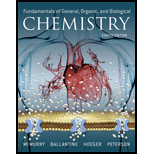
Interpretation:
The difference between drugs which are agonist and which are antagonist has to be described.
Concept Introduction:
Drugs: Drugs are molecules which are taken from an external source to change the normal functioning of the body. The action of drug is in molecular level and the design of many drugs are in such a way that it mimics a particular neurotransmitter or hormone. Drugs bind with receptors showing an increased or decreased effect.
There are two types of drugs and they are agonist and antagonist.
Agonist: They are chemical substance that binds with a receptor so that it activates the receptor for producing or prolonging its normal biochemical response.
Antagonist: They are chemical substance that binds with a receptor so that it blocks or inhibits the normal biochemical response of a particular receptor.
Want to see the full answer?
Check out a sample textbook solution
Chapter 28 Solutions
Pearson eText Fundamentals of General, Organic, and Biological Chemistry -- Instant Access (Pearson+)
- The endogenous ligand for an ion channel causes the influx of 50 Na+ ions per second. This ion channel has constitutive activity of 10 Na+ ions per second. If drug A binds to the ion channel and causes the influx of 50 Na+ ions per second, which of the following categories best describes drug A? Group of answer choices full agonist antagonist partial agonist inverse agonistarrow_forwardHow does the drugs can be classified based on their effects on receptors: full agonist, partial agonist, inverse agonist, antagonist (competitive, non-competitive, etc.).arrow_forwardWhat are the effects of agonists, antagonists, and inhibitors? Which of the types of drug actions have the stronger and weaker overall effect on the body?arrow_forward
- Methamphetamine “highs” often are accompanied by behavioral changes that resemble schizophrenia. Does methamphetamine act as an agonist or antagonist?arrow_forwardThe metabolism of drugs is meant for the inactivation of most of the drugs Explain. (Subject: pharmacology)arrow_forwardExplain synergistic vs antagonisticarrow_forward
- Why morphine show less analgesic activity after oral administration? Briefly explain at your own wordsarrow_forwardWhat are the therapeutic benefits of Benzodiazepines? list three medications in this classification?arrow_forwardDrugs that have been developed to potentiate inhibitory neurotransmitters (like gamma amino butyric acid and glycine) include all of the following except: tranquilizers tacrine ethanol valium barbituratesarrow_forward
- Why morphine show less analgesic activity after oral administration? Briefly explain at your own words Answer need.arrow_forwardDoes the more a drug interacts with multiple neurotransmitter decreases its effect and efficiency? also does a drug need to be more potent if it involves several neurotransmitters?arrow_forwardSketch the mechanism of analgesic action of morphine? Sketch at your own handsarrow_forward
- Essentials of Pharmacology for Health ProfessionsNursingISBN:9781305441620Author:WOODROWPublisher:Cengage
